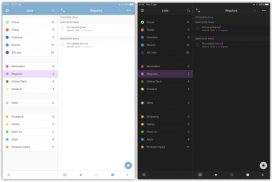

I run my life pretty much entirely inside of Things (). I think this is important context, because most productivity tools and systems fall down when you have to introduce state outside of your control, and half your time is spent syncing your to-do list with your company's JIRA board or whatever. Ask HN: What productivity tools do you use?Īs context: I live with a partner and run a SaaS with a handful of contractors.
#Goodtask ipad pro
What apps do u recommend? Side along with MacBook Pro 2014.īest GTD task manager (expensive but worth it IMO). But for now, I have to leave my dear old friend OmniFocus behind. Oh, and don’t get me wrong: I might return at some point, just as I have done with DevonThink. I certainly will write about my experiences and use case at some point. I considered several potential successors and landed on GoodTask, a highly customizable client for Apple’s Reminders app. Finally, and with a heavy heart, I decided to quit OmniFocus. I tried to force myself getting used to it and to like it for a couple of months, but to no avail. The list goes on, but I stop at this point. Especially on the iPhone, where this strip is located horizontally at the bottom of the screen, most of my Perspectives are not instantly accessible. In the new version though, Perspectives are stuck to a scrollable strip, hiding a fair amount of them. I used to use a lot of them because Perspectives are one of the most useful features in OmniFocus. Also, the new way of displaying Perspectives is not a good fit, in my opinion. And except for safety concerns, redundancy is not a great design principle. For example, why do we need two inspector views, one inline and one as a separate pane? This does not just feel redundant, it is redundant. Instead of simplifying things, they added complexity and visual overload. In my eyes, the old design and way of handling things was way more intuitive. It also became more complicated than it has been before. Redundancy is not a good design principle It feels like they try to implement a modern interface by using Swift UI, while sticking to too much cruft from all those years. Unfortunately, the new version tries to look modern, not be modern. Otherwise, I wouldn’t have used it for years in the first place. OmniFocus always had a busy interface, and I am fine with that. And they delivered on this front: the new design looks way more modern than the old one. It is true that OmniFocus looks quite dated and that a new approach is urgently needed. The stroke that broke the camel’s back, though, was the ongoing beta for the new iPad/iPhone version. I am not certain if this is something that serves them well in the future. I just think that they have left an approach which is useful to most of their users. Don’t get me wrong, no offense against extreme automation power users. However – how many users need this on even a semiregular basis? It seems to me that this is only used by such a tiny fraction of the user base that it feels more like being developed for themselves and probably a handful of extreme automation power users. Yes, it is an incredible achievement from a technical standpoint. I had this feeling first when OmniFocus introduced its built-in automation engine. However, sometimes it feels like a company is moving in a direction you don’t want to follow anymore. One could say, it was the most important app in my life. Most days, OmniFocus’ familiar interface was the first thing in the morning and the last in the evening on my computer screen. OmniFocus was an integral part of my productivity system. Even more so after reading Kourosh Dini’s excellent book Creating Flow with OmniFocus. For ages, I’ve been a devout OmniFocus user.


 0 kommentar(er)
0 kommentar(er)
